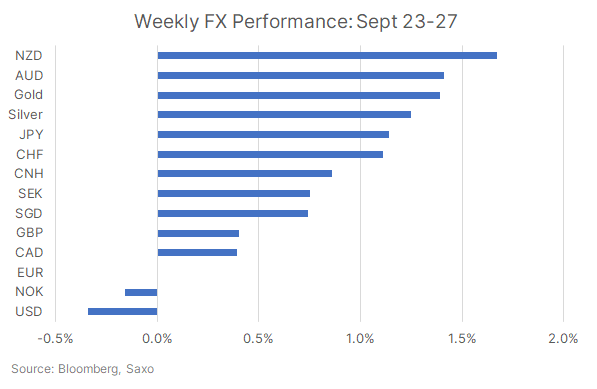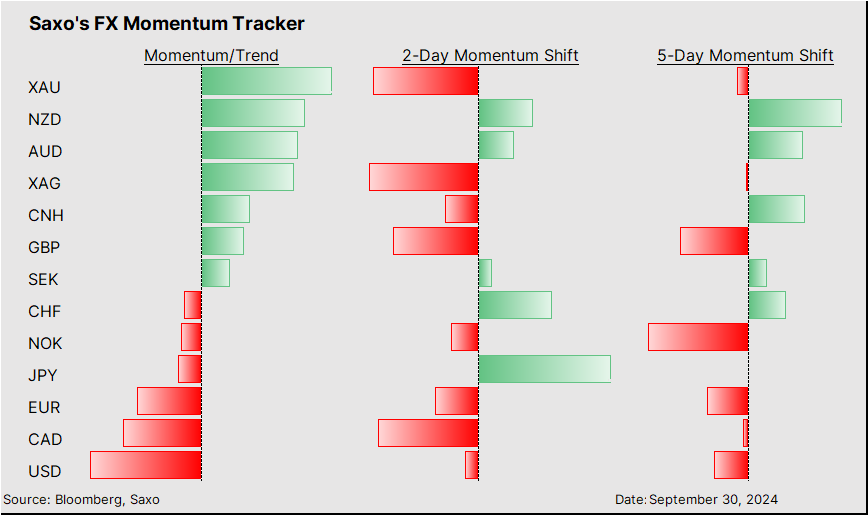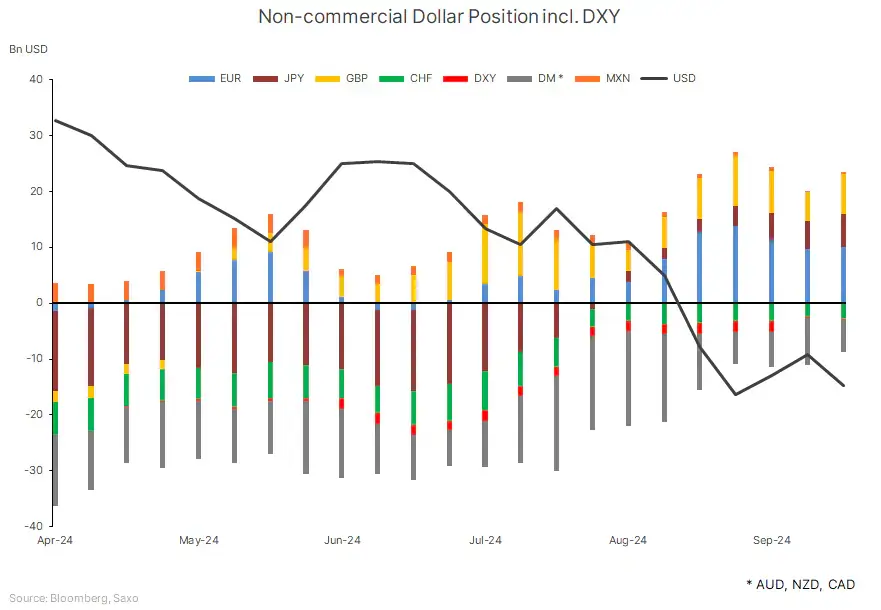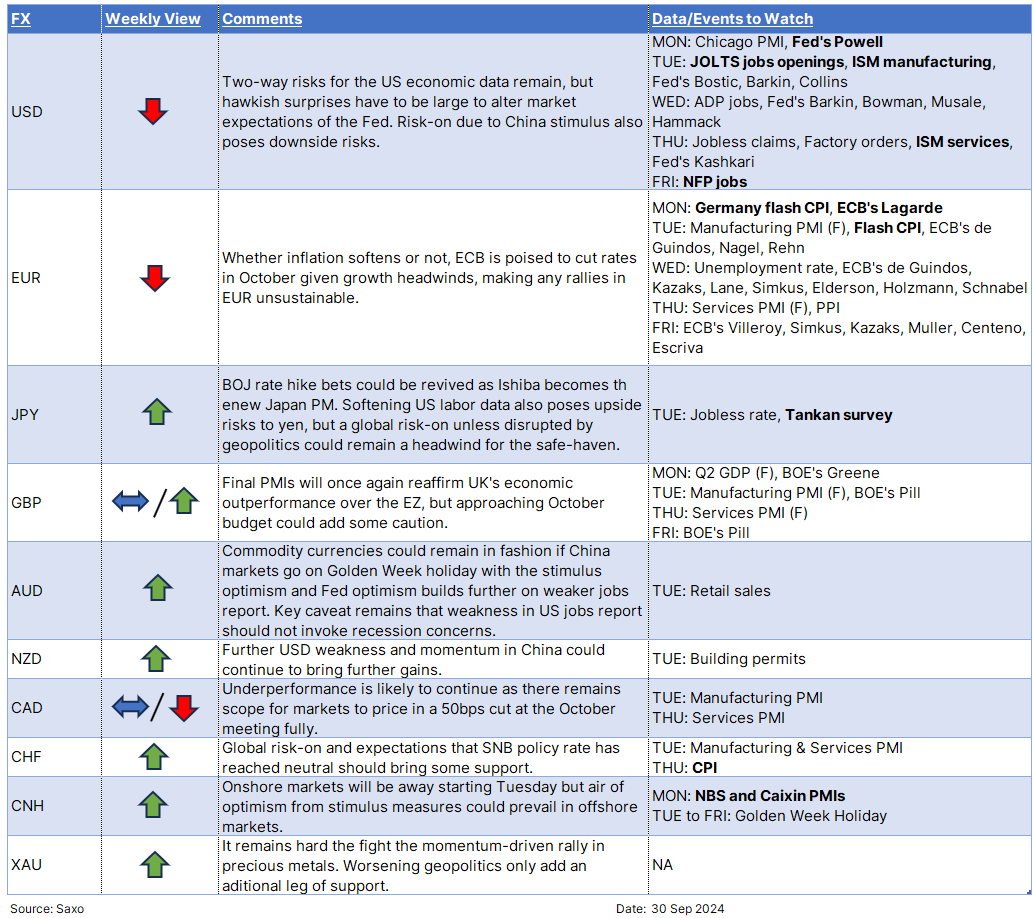Key points:
-
USD: Downside pressures could persist if soft-landing expectations remain.
-
JPY: Hawkish PM adds to the bull case.
-
EUR: Growth headwinds to pave way for ECB’s October rate cut.
-
AUD: Boosted by China stimulus.
USD: NFP data is a key input Fed’s November decision
The narrative of a soft landing continues to shape the outlook for the USD, leaning on the weaker side. Recent US data has pointed toward this scenario, which is USD-negative, and the upcoming jobs report is likely to reaffirm this trend. The bar for a hawkish surprise is high, while a somewhat weak headline jobs growth could propel markets to price in another 50bps rate cut from the Fed in November. Meanwhile, China's stimulus measures are boosting global risk appetite, adding further downside pressure on the USD.
This week will also feature remarks from several Fed members, including Chair Powell and the dissent voter Bowman. However, with the dot plot has already laid out the variance of views in Fed's expected path forward, and the commentary is unlikely to break this confusion. Focus remains heavily tilted toward key data points, especially Friday’s nonfarm payrolls but also ISM manufacturing and services PMIs. September's NFP is expected to show 145k new jobs, with the unemployment rate steady at 4.2%, and average hourly earnings growth easing slightly. Before that, Tuesday's ISM Manufacturing and Thursday's ISM Non-Manufacturing PMIs will be scrutinized for signs of how the US economy wrapped up Q3.
For the USD to sustain any gains, both the jobs report and ISM data would need to exceed expectations. However, the odds are stacked toward a balanced, but dovish, outcome, meaning the dollar may struggle to hold ground if the data confirms the soft-landing narrative.
JPY: New PM’s hawkish vibes add to Yen’s bull case
In Friday's election, Shigeru Ishiba emerged victorious as the ruling party leader in a run-off against dovish candidate Sanae Takaichi, signaling a potential shift in Japan’s economic stance. Ishiba has voiced support for the Bank of Japan’s independence and its normalization strategy, suggesting a firmer focus on tackling deflation. His election could mark a turning point in monetary policy discussions, with the new Prime Minister reportedly planning a general election on October 27.
This leadership change adds a layer of uncertainty for JPY, as markets will look closely at Ishiba's approach to monetary policy and how it aligns with the BoJ's potential hawkish shift. As much as politics and central banks should be independent, there is a fair chance that Ishiba-san’s hawkish comments could feed into BOJ’s policy thinking. We still expect caution on further policy hikes after August’s Black Monday, but wage-price spiral suggests that the BOJ has room to normalize policy further. With the yen already benefiting from lower oil prices, Fed’s 50bps rate cut, and the possibility of BoJ rate hikes, Ishiba’s election win could accelerate bullish sentiment on JPY, especially against currencies like the EUR, where expectations for further rate cuts are firmer.
Commodity currencies: CAD could extend its underperformance
The outlook for commodity currencies like AUD, NZD, and CAD has shifted with China’s recent stimulus, adding to the positive narrative already building from the Fed's soft-landing scenario, with a 50bps rate cut at the September meeting. However, CAD has been the underperformer, with the Canadian economy facing hard-landing risks. Inflation returned to the 2% target in August, and markets still expect more rate cuts from the BoC, adding to CAD’s downside pressure.
Meanwhile, the RBA has pushed any potential rate cut discussion to 2025, while the RBNZ appears overpriced, with markets forecasting 90bps of cuts over the next two meetings before year-end. CAD’s underperformance may continue for now, especially until US election risks could start to take a larger role in markets. CAD faces fewer tariff risks compared to the other commodity currencies, and its fate could turn if a Republican victory becomes more likely in the US elections.

Risk-on mood was boosted by China stimulus after the Fed's 50bps rate cut. and activity currencies like NZD and AUD outperformed. JPY and CHF also gained with the former boosted by local election results and latter by SNB's less dovish-than-feared rate cut.
Our FX Scorecard shows bullish momentum in Gold and Silver retreating, and bearish momentum continuing to build further in CAD. JPY and CHF see the most bullish shift in momentum in the last two days.
The CFTC positioning data for the week of 24 Sept saw speculators selling USD once again after two weeks of short-covering. All major currencies except CHF saw net buying, led by high-beta currencies GBP and AUD.
Read the original analysis: Weekly FX chartbook: China stimulus adds to Fed-driven risk-on ahead of jobs day
The Saxo Bank Group entities each provide execution-only service and access to Analysis permitting a person to view and/or use content available on or via the website. This content is not intended to and does not change or expand on the execution-only service. Such access and use are at all times subject to (i) The Terms of Use; (ii) Full Disclaimer; (iii) The Risk Warning; (iv) the Rules of Engagement and (v) Notices applying to Saxo News & Research and/or its content in addition (where relevant) to the terms governing the use of hyperlinks on the website of a member of the Saxo Bank Group by which access to Saxo News & Research is gained. Such content is therefore provided as no more than information. In particular no advice is intended to be provided or to be relied on as provided nor endorsed by any Saxo Bank Group entity; nor is it to be construed as solicitation or an incentive provided to subscribe for or sell or purchase any financial instrument. All trading or investments you make must be pursuant to your own unprompted and informed self-directed decision. As such no Saxo Bank Group entity will have or be liable for any losses that you may sustain as a result of any investment decision made in reliance on information which is available on Saxo News & Research or as a result of the use of the Saxo News & Research. Orders given and trades effected are deemed intended to be given or effected for the account of the customer with the Saxo Bank Group entity operating in the jurisdiction in which the customer resides and/or with whom the customer opened and maintains his/her trading account. Saxo News & Research does not contain (and should not be construed as containing) financial, investment, tax or trading advice or advice of any sort offered, recommended or endorsed by Saxo Bank Group and should not be construed as a record of our trading prices, or as an offer, incentive or solicitation for the subscription, sale or purchase in any financial instrument. To the extent that any content is construed as investment research, you must note and accept that the content was not intended to and has not been prepared in accordance with legal requirements designed to promote the independence of investment research and as such, would be considered as a marketing communication under relevant laws.
Recommended Content
Editors’ Picks

EUR/USD treads water just above 1.0400 post-US data
Another sign of the good health of the US economy came in response to firm flash US Manufacturing and Services PMIs, which in turn reinforced further the already strong performance of the US Dollar, relegating EUR/USD to the 1.0400 neighbourhood on Friday.

GBP/USD remains depressed near 1.2520 on stronger Dollar
Poor results from the UK docket kept the British pound on the back foot on Thursday, hovering around the low-1.2500s in a context of generalized weakness in the risk-linked galaxy vs. another outstanding day in the Greenback.

Gold keeps the bid bias unchanged near $2,700
Persistent safe haven demand continues to prop up the march north in Gold prices so far on Friday, hitting new two-week tops past the key $2,700 mark per troy ounce despite extra strength in the Greenback and mixed US yields.

Geopolitics back on the radar
Rising tensions between Russia and Ukraine caused renewed unease in the markets this week. Putin signed an amendment to Russian nuclear doctrine, which allows Russia to use nuclear weapons for retaliating against strikes carried out with conventional weapons.

Eurozone PMI sounds the alarm about growth once more
The composite PMI dropped from 50 to 48.1, once more stressing growth concerns for the eurozone. Hard data has actually come in better than expected recently – so ahead of the December meeting, the ECB has to figure out whether this is the PMI crying wolf or whether it should take this signal seriously. We think it’s the latter.

Best Forex Brokers with Low Spreads
VERIFIED Low spreads are crucial for reducing trading costs. Explore top Forex brokers offering competitive spreads and high leverage. Compare options for EUR/USD, GBP/USD, USD/JPY, and Gold.


